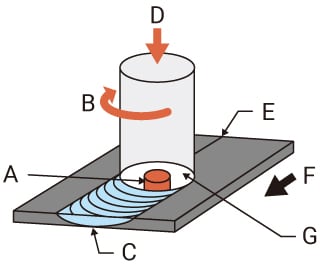Friction welding
Friction welding is considered environmentally friendly, making it a popular choice for factory automation. This page introduces friction stir welding (FSW), the technique for achieving excellent joint smoothness.
This method generates high-speed friction between thebase materials(metal or resin) to soften them with the heat generated by the friction and then applies pressure to join them. It is said to be an eco-friendly joining method because it does not need a heat source other than friction heat, removes the need for welding rods orflux, and does not producespatteror gas as compared to arc welding or gas welding.
Friction welding can be also performed based on three factors of friction thrust (pushing force), rotation speed and time. Since all of these can be controlled numerically, friction welding can be controlled automatically without human intervention and is widely used in FA (factory automation).
Friction stir welding (FSW), a variant of friction welding, has attracted a lot of attention. The process rotates a cylindrical tool with a probe (protrusion) at high speed and moves the tool so that the probe digs along the joining section with high pressure. The rotating tool softens the base materials and stirs the area around the weld to cause plastic deformation and atomic bonding between the materials.
- Friction stir welding (FSW)
-

- 探针
- Rotation
- Weld zone
- Pressurization by the tool
- Butt surfaces
- Plate movement
- Shoulder






